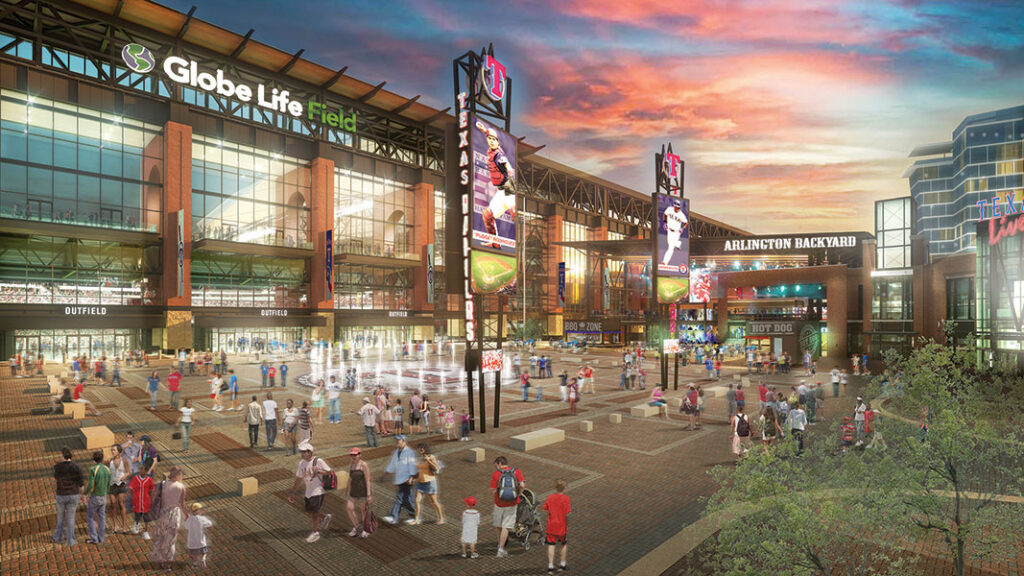From façades to concourses and VIP suites, the modern sports venue takes cues from the retail and hospitality sectors
By Stacie Dinwiddy
When you look back on your experiences at various sporting events, where do your memories take you? Back to your seats? That time you were close enough to high-five your favorite players or in just the right spot to catch that game-winning home run? Perhaps your memories are more sensory. The unmistakable taste of processed cheese smothering your nachos? But what of the arenas and stadiums—any memories of the venue itself?
I spent most Saturdays over the course of five years roaming the concourses and stands at the L.A. Coliseum, a venue that has hosted two Olympics, two Super Bowls, a World Series and a Papal Mass. But in my recollection of those events and others, the venues are mere destinations. I recall more fondly the experience of the journey there, as well as the action in and around the stadium.
Today, all of that has changed, with the “individual journey” central to the transformation of stadiums into urban icons and visionary feats of planning—engines for economic growth, cultural renaissance and urban development. Stadiums and venues now anchor sports entertainment districts, yielding economic dividends, community benefits and real-estate opportunities that far extend the typical tax-revenue analysis originally generated from projected ticket, food and merchandise sales within the stadium.
As with hospitality design, there is a strong focus on designing catalysts for public infrastructure and communal space that provoke interaction within the community as well as redevelopment of the neighborhood. Out with idle parking lots in suburban expanses and in with year-round revenue-producing stores, offices and residences—dynamic and mixeduse environments that can be utilized without always knowing the actual stadium is part of the venue.
Lighting installations—interior and exterior—were not a provision in stadium design until the 1950s when they were added to enable nighttime television broadcasts. Since then, exterior lighting applications have evolved to engage the façade material or structure; create a display for information; and incorporate a wow factor using the latest technologies.
For example, many international venues utilize lightweight transparent architectural skins highlighted or entirely illuminated with integral color-changing LED technology to generate a dual day and night experience for the venue exterior. This copolymer material of ethylene and tetrafluoroethylene, called ETFE, is just 1% the weight of glass. Color, however, isn’t a requirement for creating a standout façade. For the Amazonia Arena, built for the 2014 World Cup games in Rio de Janeiro, warm white backlighting creates a soft lantern effect and maintains a sensitivity to the surrounding natural environment.
When mounted between the structure and inner bowl, lighting that is direct or indirect may reveal the voids and expose the three-dimensionality of structural steel skeletons or perforated metal skins of such organic sculptures as the Borisov Arena in Belarus and the National Stadium in Beijing.
Applying light directly to the façade, of course, is also effective. Whether it’s a continuous row of fixtures grazing the face of a monolithic façade or individual light fixtures mounted to each vertical element of the structure or membrane, these applications prove that lighting can enliven the venue’s nighttime visual and define the stadium as an icon.
Finally, exterior lighting can be used for sponsorship and advertising in the form of a façadesized billboard. Franchises, players and real-time highlights projected across walls and the sky-facing fifth façade offer new ways to engage the surrounding community. For the budget conscious, informative façade lighting doesn’t require the latest roof cladding technology. A smart control system and either a single-color or dynamic color-changing LED light fixture can support events happening in and around the venue—to indicate the current home team playing; support a local group or movement; or celebrate a holiday.
With the introduction of television broadcasting, stadium design was forced to deliver amenities and a viewing experience worth the hours spent idle in nearby traffic. Venue interiors were equipped with features and facilities to improve the comfort of spectators and encourage fans to stay longer, including covered stands, additional toilet facilities, and food and drink. Lighting technologies beyond the field provided design opportunities and means of wayfinding, identity and allurement.
Much like your local shopping mall, general lighting within the concourse once aimed to take away the darkness with little or no indication of direction. The design and placement of graphics and signage was the key to wayfinding success. Today, taking cues from retail, these paths are no longer programmed to get patrons from A to B with some sport in between, but rather to be meandering streets lined with opportunities and more than one point of arrival. For lighting designers, concourses offer a playground of possibilities to create memorable moments leaving guests to wonder what’s next as they round the bend or turn the corner. The scale of these moments can be in the details or all overhead as a pattern or direction.
Using feature lighting to enhance significant points of arrival maintains those memorable moments for guests. Whether the design and budget are more elaborate—with the use of integrated fiber optics or curved linear light patterns—or more practical—with a single illuminated symbol or art piece— there may only be a handful of these arrival points, allowing for design considerations to introduce custom decorative pieces or specialty light fixtures.
Who has attended an event, be it a trade show, sport, concert or theatrical show, and had to meet the rest of your party beyond the ticket gates? Slight variations in fixture type, mounting height or color temperature now distinguish the “moving zones” from those where guests may sit or stand still. Variations should be simple but noticeable—if it’s a point source providing the functional light, add a decorative shade or bulb to those over standing zones or change to a linear pendant to emphasize the difference in zones.
Where there are food and drink offerings in and around the concourse, manipulation of the ceiling plane and large-scale decorative fixtures create intimacy, a word not previously associated with stadiums. As with sports, there is an associated sense of motion as we continue our journey to our seats, and these pocket neighborhoods invite us to slow down and hang out before, during and after the game.
Similarly, the notion of tailgating has made its way indoors. These new hangouts include bars and show kitchens highlighted with integral lighting and dropped soffits that conceal or incorporate a repetitive pattern of decorative lights. No longer exclusive and not all focused on the field, restaurants feel more like your local bar and grill and can offer exclusive local food and fan-based atmosphere. Layers of lighting integrated with the architecture or exposed in a playful manner add flair, while lighting controls with pre-set scenes accommodate settings and light levels for both corporate and family dining at any time of day and throughout the year.
Driven by hospitality, venues are now equipped to compete for business typically reserved for restaurants and banquet halls. High-end seats with a premium view now afford an experience inside VIP clubs, where bar faces are grazed with linear light or backlit with panels to draw you in and through the space. Lighting applications incorporate bespoke fixtures on display or standard fixtures concealed by decorative ceiling soffits, while colorchanging effects emphasize the sponsored brand and identify with the home team.
Suites can deliver both amenities and viewing experience. Lensed fixtures can provide diffuse lighting in neutral color temperatures to reduce contrast between bowl and suite thresholds, while decorative pendants and recessed adjustable accent lights provide sparkle. The use of colored lighting is likely to be static and restricted to team colors. Local keypads offer pre-set lighting scenes to accommodate optimal atmosphere for day or night games.
What experience will lighting design evoke as the architecture of our society’s modern-day social hub continues to evolve? Advanced lighting and controls have already extended the spectator-based experience of stadium architecture beyond the bowl to communities, cities and as icons of countries around the world. With this new perspective, fans and spectators alike will continue to seek out entertainment experiences throughout the stadium—while never missing the tackles, tumbles and touchdowns that brought them there in the first place.
This article is based on a presentation delivered at IALD Enlighten Americas 2018 and LEDucation 2019.


